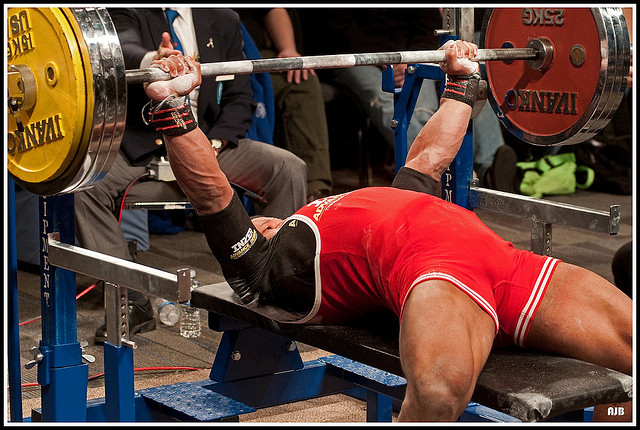Many beginners are unsure of the correct breathing technique in weight lifting. It’s very simple.
You breathe out when you make the effort.
A full pair of lungs and a contracted ribcage give you added stability through intra-abdominal pressure and ability to lift more as well as plenty of fresh oxygen when you need it most. Intra-abdominal pressure is important in order to stabilise the spine during heavy lifting. Getting your breathing sequence right is as important as mastering form for an exercise.
Here are a few examples of when to breathe in and out for specific exercises.
Squats
You are in position with the bar on your shoulder, ready to squat down. As you lower yourself, take a very deep breath. A really deep breath as this is the squat. It’s a hard exercise and puts your spine under a heavy load. So you want to get this intra-abdominal pressure very high to stabilise the spine.
Once you reach the bottom, inhalation is complete. Now push up and as you push, exhale slowly to match your effort. As you reach the sticking point in the squat where effort is maximal, you may want to exhale even more slowly or even hold your breath. As you reach the top in a standing position, your lungs should be empty or nearly empty. Get ready for the next rep or take a very brief pause to catch your breath if you have performed many reps already and are out of breath.
Getting the breathing technique right is crucial to the squat, more than any other exercises.
Bench press
Inhale deeply as you lower the bar to your chest. Your chest expands at the same time as you fill it with air. This is a good thing as it goes up to meet the bar and shortens the distance the bar has to travel down, translating into less concentric effort for you. The correct posture also requires a slight curve in the back and your expanded chest contributes to that.
The bar touches your chest and you start pushing it up. Start exhaling forcefully and slowly at this point. You may want, once again to exhale ever so slowly and even more forcefully during the sticking point, even holding your breath to get past it. At the top, your lungs are empty or nearly.
Barbell row
We’ve covered the right breathing technique for two fundamental pushing exercises. Let’s have a look at a compound pulling exercise now.
You’re standing in front of a loaded bar lying on the floor. Grasp it, lift it and get into position with your back bent at the hip, ready to start the row. Your arms are straight. Take a deep breath, then with your lungs full, start pulling the bar towards your navel. As you pull, exhale. When the bar reaches your belly, your lungs should be empty. As you lower the bar, inhale deeply. When the bar reaches the bottom, your lungs should be full and ready to exhale again as you start the next rep. there is no sticking point in the rowing exercise. Make sure you only start pulling the bar when your lungs are full – don’t pull the bar while still inhaling in the first rep. You should start exhaling as you start pulling the bar in fact.
Curls
Since the biceps curl is a popular exercise among newbies, I thought I’d cover it too. This applies for any type of curl. With the bar in your hands and your arms straight down, inhale first; once your lungs are full, curl up the bar while exhaling. There is a sticking point in the curl. Exhale more slowly at this point or even hold your breath until you get past it. Exhale completely as you reach the top; inhale fully as you lower the bar again to complete the rep and start the next one.
As you can see, the breathing technique doesn’t change for any exercise – you exhale forcefully as you exert yourself, whether in a pushing or pulling exercise.
Warning
Holding your breath during the hardest part of the exercise helps build up intra-abdominal pressure even more and provide you with more stability and power. However, this is at the expense of drastically increasing your blood pressure. So if you have a history of high blood pressure, avoid holding your breath even though you will slightly lose out on performance. If you feel dizzy or have a headache after a particularly hard exercise, this may be the result of a high blood pressure.


